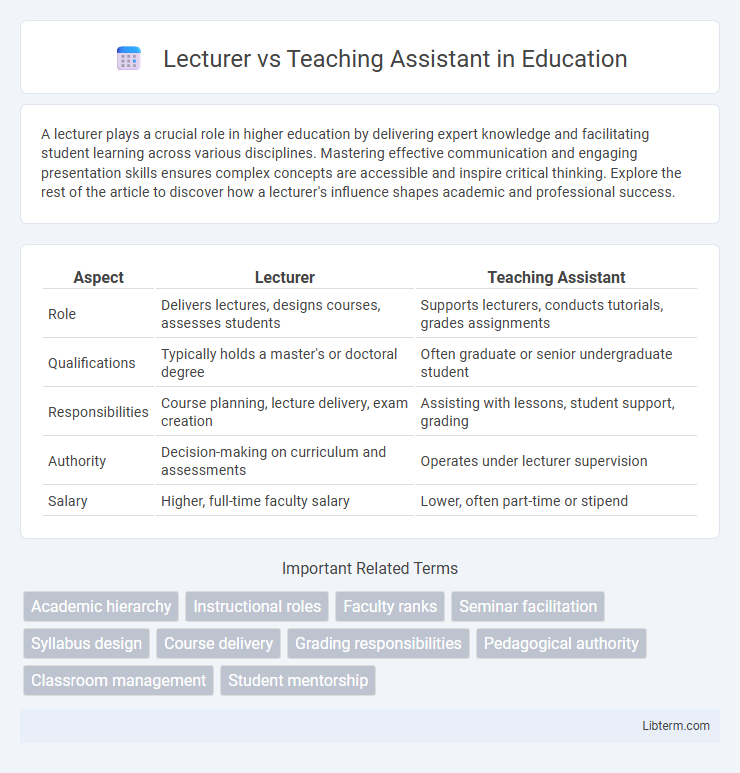A lecturer plays a crucial role in higher education by delivering expert knowledge and facilitating student learning across various disciplines. Mastering effective communication and engaging presentation skills ensures complex concepts are accessible and inspire critical thinking. Explore the rest of the article to discover how a lecturer's influence shapes academic and professional success.
Table of Comparison
| Aspect | Lecturer | Teaching Assistant |
|---|---|---|
| Role | Delivers lectures, designs courses, assesses students | Supports lecturers, conducts tutorials, grades assignments |
| Qualifications | Typically holds a master's or doctoral degree | Often graduate or senior undergraduate student |
| Responsibilities | Course planning, lecture delivery, exam creation | Assisting with lessons, student support, grading |
| Authority | Decision-making on curriculum and assessments | Operates under lecturer supervision |
| Salary | Higher, full-time faculty salary | Lower, often part-time or stipend |
Lecturer vs Teaching Assistant: Key Role Differences
Lecturers primarily design course curricula, deliver lectures, and assess student performance, holding advanced academic qualifications and often conducting research. Teaching Assistants support lecturers by facilitating discussion groups, grading assignments, and providing one-on-one student assistance, usually while pursuing their own studies. The key difference lies in their responsibilities and authority levels, with lecturers leading instructional planning and TAs offering supplementary educational support.
Qualifications Required for Lecturers and TAs
Lecturers typically require a minimum of a master's degree, with many institutions favoring or requiring a doctoral degree to demonstrate advanced expertise in the subject area. Teaching Assistants generally need to be enrolled in a graduate program or possess a related bachelor's degree, often requiring prior coursework or research experience relevant to the course they support. Both roles demand strong communication skills, but lecturers must additionally exhibit a proven track record of academic research or professional experience.
Primary Responsibilities: Lecturer vs Teaching Assistant
Lecturers primarily design and deliver course content, assess student performance, and conduct academic research to contribute to their field. Teaching Assistants support lecturers by facilitating tutorials, grading assignments, and providing one-on-one student assistance to enhance learning outcomes. Both roles collaborate to ensure effective educational delivery, but lecturers hold greater responsibility for curriculum development and academic leadership.
Teaching Methods and Styles Compared
Lecturers typically employ formal, lecture-based teaching methods focusing on comprehensive topic delivery and theoretical frameworks, while Teaching Assistants often adopt interactive and supportive styles, facilitating discussions, group work, and personalized guidance. Lecturers prioritize structured curricula and assessment design, whereas Teaching Assistants emphasize student engagement and practical application through hands-on activities and feedback sessions. These complementary roles create a dynamic learning environment balancing authoritative instruction with collaborative support.
Interaction with Students: Lecturer vs TA
Lecturers typically lead formal classroom instruction, delivering lectures and setting course objectives, which positions them as primary sources of knowledge and authority for students. Teaching Assistants (TAs) engage more directly in personalized interaction, including facilitating discussion sections, grading assignments, and providing individualized support to clarify concepts. This dynamic enables TAs to build closer rapport with students, addressing diverse learning needs more flexibly than the often larger-scale, agenda-driven lectures conducted by lecturers.
Workload and Time Commitments
Lecturers typically manage heavier workloads with responsibilities including course planning, delivering lectures, grading, and office hours, requiring an average of 40-60 hours per week. Teaching Assistants usually have more limited time commitments, often assisting with grading, leading discussion sections, and providing student support, ranging from 10-20 hours weekly. The workload for lecturers is generally more intensive and consistent, while TAs experience variable commitments based on course demands.
Career Progression Opportunities
Lecturers typically have broader career progression opportunities, advancing to senior lecturer, principal lecturer, or academic management roles such as department head or dean. Teaching assistants primarily support instructional activities and often require further qualifications to transition into lecturer positions or other academic roles. Career growth for teaching assistants is usually tied to acquiring advanced degrees and gaining teaching experience.
Salary and Compensation Differences
Lecturers typically receive higher salaries than Teaching Assistants due to their full teaching responsibilities and advanced qualifications, with average annual pay ranging from $50,000 to $80,000 depending on the institution and region. Teaching Assistants often earn stipends or hourly wages, generally between $15,000 and $30,000 annually, as they support professors and handle limited instructional duties. Compensation packages for Lecturers may include benefits such as health insurance and retirement plans, while Teaching Assistants frequently have more modest or part-time benefits.
Challenges Faced by Lecturers and Teaching Assistants
Lecturers face challenges such as managing large class sizes, preparing comprehensive course materials, and balancing research obligations alongside teaching responsibilities. Teaching assistants often struggle with limited authority in the classroom, unclear role definitions, and the pressure of supporting both students and lecturers effectively. Both roles require strong communication skills and adaptability to address diverse student needs and institutional demands.
Choosing the Right Path: Lecturer or Teaching Assistant
Choosing the right path between Lecturer and Teaching Assistant depends on career goals, academic qualifications, and desired responsibilities within education. Lecturers often require advanced degrees, like a Master's or PhD, and focus on delivering lectures, curriculum development, and research, while Teaching Assistants support professors by facilitating discussions, grading, and providing student assistance. Evaluating involvement level, workload, and long-term career aspirations helps determine the best fit for academic and professional growth.
Lecturer Infographic

 libterm.com
libterm.com